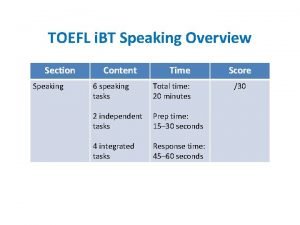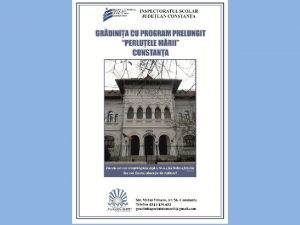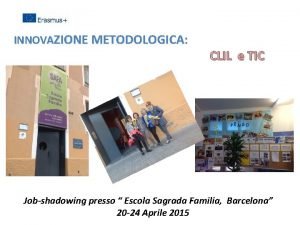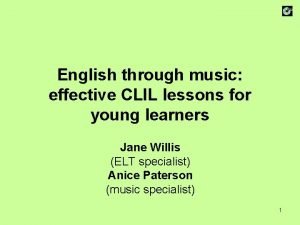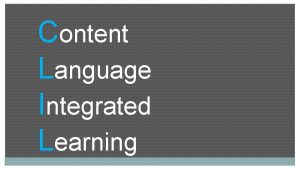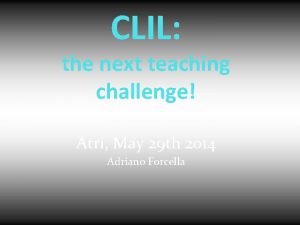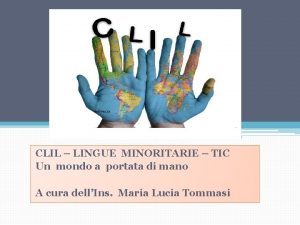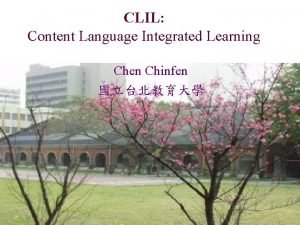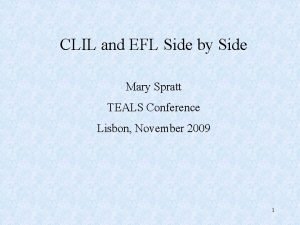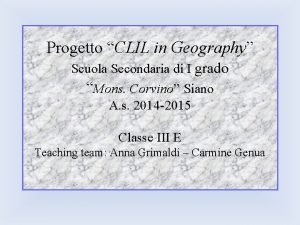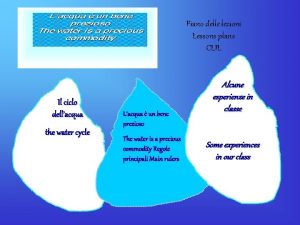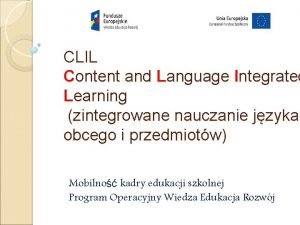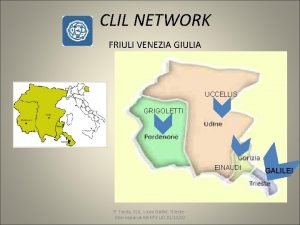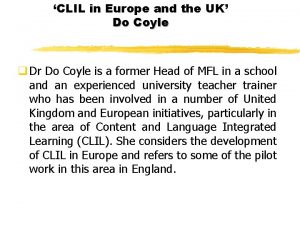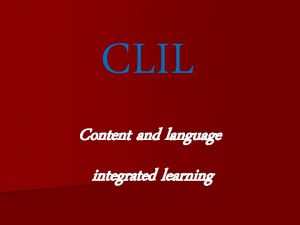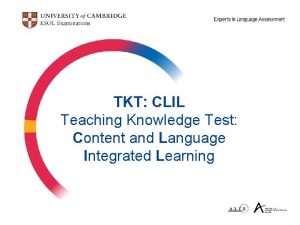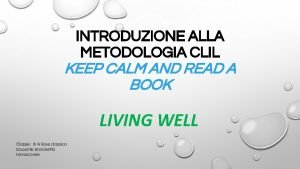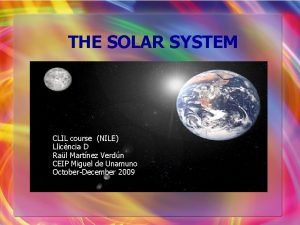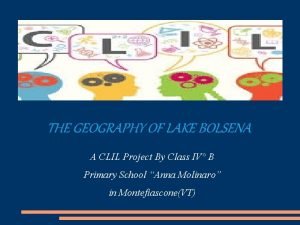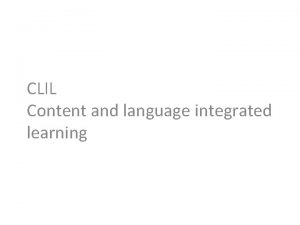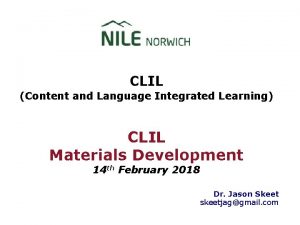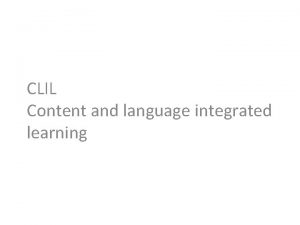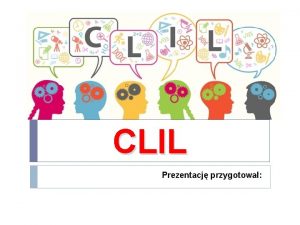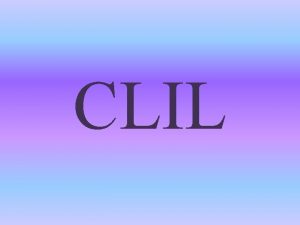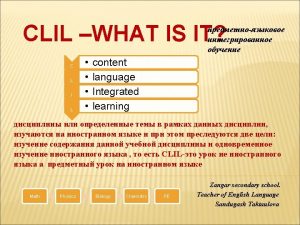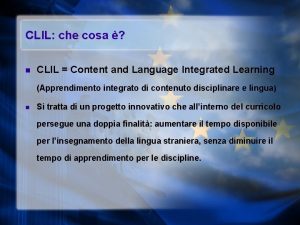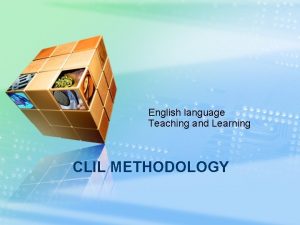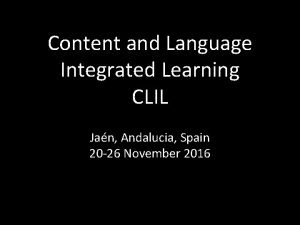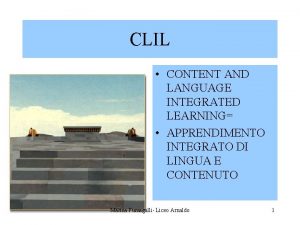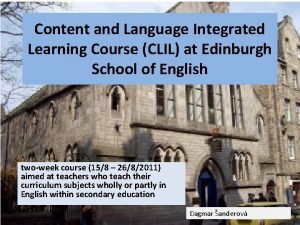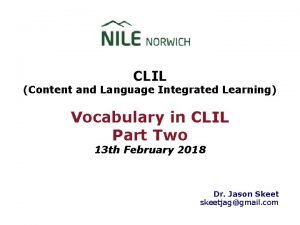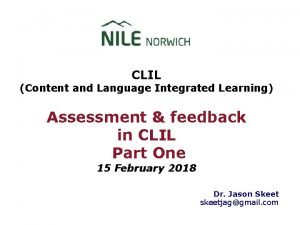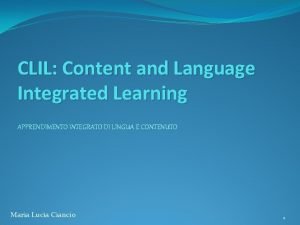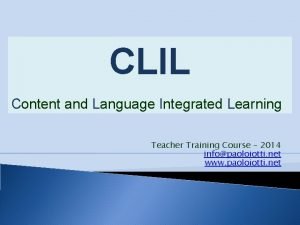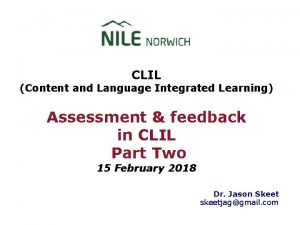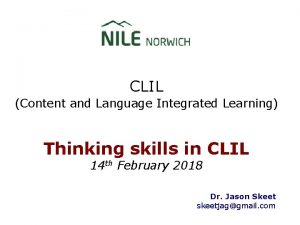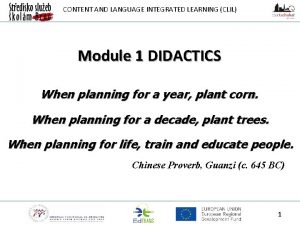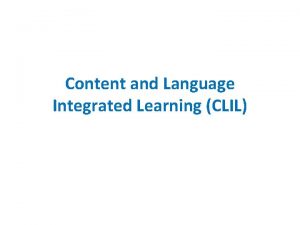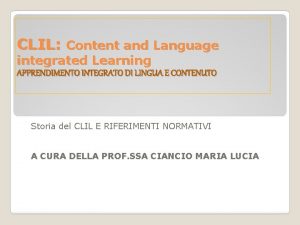Content and Language Integrated Learning CLIL An Overview





























- Slides: 29

Content and Language Integrated Learning (CLIL) An Overview Áine Furlong Waterford Institute of Technology afurlong@wit. ie Áine Furlong, W. I. T. , February 2009

The term CLIL Generic umbrella term encompassing any activity in which a foreign language is used as a tool in the learning of a non-language subject in which both language and the subject have a joint curricular role. Áine Furlong, W. I. T. , February 2009

Definition • CLIL is a dual-focused educational approach in which an additional language is used for the learning and teaching of both content and language. • CLIL is not language for specific or vocational purposes. It is about teaching important aspects of a subject through a foreign language. • For more detail, see www. clilmatrix. ecml. at Áine Furlong, W. I. T. , February 2009

Core characteristics of CLIL/EMILE • The major concern is Education and not multilingualism • Mutilingualism is the added value • Methodology is at the core of the approach. • Strength of this approach: • Re-thinking of how and when certain types of subject matter and language are taught • Inter-disciplinary mindset • Weakness of the approach: • High vulnerability during the introductory phase • Challenges to cultural and professional territorialism Áine Furlong, W. I. T. , February 2009

Reasons for CLIL/EMILE • • The reasons are known as: Dimensions (5 major reasons) Focuses (18 sub-reasons) The culture dimension The environment dimension The language dimension The content dimension The learning dimension Áine Furlong, W. I. T. , February 2009

The culture dimension • Building intercultural knowledge and understanding • Developing intercultural communication skills • Learning about specific neighbouring countries, regions or minority groups • Introducing the wider cultural context Áine Furlong, W. I. T. , February 2009

The environment dimension • Preparing for internalisation and EU integration • Accessing international certification • Enhancing school profile Áine Furlong, W. I. T. , February 2009

The language dimension • Improving overall target language competence (4 skills) • Developing oral communication skills (using the language in real-life situations) • Deepening awareness of mother tongue and target language (language-sensitive curriculum) • Developing plurilingual interests and attitudes • Introducing a target language (a language can be introduced in a non-formal way to stimulate interest in further study of that language Áine Furlong, W. I. T. , February 2009

The content dimension • Providing opportunities to study content through different perspectives • Accessing subject-specific target language terminology • Preparing for future studies and/or working life Áine Furlong, W. I. T. , February 2009

The learning dimension • Complementing individual learning styles • Diversifying methods and forms of classroom practice • Increasing learner motivation (low exposure CLIL/EMILE programmes, immediate relevance) Áine Furlong, W. I. T. , February 2009

Criticism of CLIL/EMILE • CLIL promotes English at the expense of other languages • Much of the criticism of CLIL is aimed at 1 particular type of programme (high CLIL/EMILE exposure over a long period of time in a single language, English) CLIL promotes English at the expense of other languages • The current view is that less exposure to CLIL/EMILE may be better than more Áine Furlong, W. I. T. , February 2009

More observations! • ‘ Using a foreign language as a vehicular language requires methods, teaching styles and strategies which are… • neither in the traditional repertoires of foreign language teachers and … • not in the repertoires of the non-language subject teaching’ (Helfrich 1993). Áine Furlong, W. I. T. , February 2009

What can a language teacher bring to CLIL/EMILE? • • • Linguistic and cultural knowledge Language learning methodologies An open mind Wolff (1998) states that: ‘it is absolutely necessary to reform language teaching…What is new is the way in which different language learning approaches which have developed in isolation, are brought together in order to promote more efficient language teaching and multilingualism’. Áine Furlong, W. I. T. , February 2009

CLIL programmes • • The context determines the type of CLIL/EMILE programme that will be adopted. The programme will be situated along a continuum from language driven to content-driven and should aim to be dual-focused. Language driven content is used to teach L 3 structures and skills Content-driven content is more important than the language (immersion and bilingual and earlier CLIL programmes) Thematic modules Parallel teaching of the language and the content Small daily doses of CLIL/EMILE Áine Furlong, W. I. T. , February 2009

The 4 Cs curriculum (Do Coyle 2005) • Content: progression in knowledge and skills; • Communication : interaction and using language to learn; • Cognition: engagement: thinking and undertanding; • Culture: self and other awareness/ citizenship. Áine Furlong, W. I. T. , February 2009

Proficiency: BICS and CALP Cummins (1984) • BICS = Basic Interpersonal Communication Skills • Highly contextualised, lower cognitive demands (language is only one element in the communication process – others include mime, facial expressions…) • CALP = Cognitive-Academic Language Proficiency • Less contextualised, higher cognitive demands (activities in which language has to do all the work – writing letters, listening to the radio…) • Tasks may be plotted at any point on the dimensions of cognitive demand contextualisation Áine Furlong, W. I. T. , February 2009

BICS: contextualised language + low cognitive demand X: decontextualised language + low cognitive demand Y: contextualised language + high cognitive demand CALP: decontextualised language + high cognitive demand Áine Furlong, W. I. T. , February 2009

The CLIL Matrix High cognitive demands 3 4 Low linguistic demands High linguistic demands 2 1 Low cognitive demands Áine Furlong, W. I. T. , February 2009

At Third level • Joint programmes are seen as a major platform on which to gain a competitive edge (CLIL could play a major role). • CLIL experiences are recordable on ELP or a similar accreditation reference frame. Focus on partial competencies (e. g. reading) can also be recorded and accredited. • CLIL can be introduced in conjunction with ICT Áine Furlong, W. I. T. , February 2009

At Second Level • The teacher is a prisoner of his/her own specialism; • The teacher does not always have pedagogical training (ENLU Task force 4 2004); • The concepts taught are complex and the L 3 can become an obstacle in the acquisition of the concept. Áine Furlong, W. I. T. , February 2009

Challenge 1 Challenge 2 Transforming content into comprehensible input 1. Sensitisation : Sensorial Cognitive Plurilingual Communicative approaches Generating comprehensible output 2. Research: Mapping one’s understanding. Task-based Learning. Learner Autonomy. 3. Development : Learner takes responsibility for sharing knowledge. Áine Furlong, W. I. T. , February 2009 4. Consolidation (language) and synthesis (content): Lexical, cognitive and communicative approaches

1. Sensitisation Davis and Rinvolucri 1988 : Dictation: new methods, new possibilities. Text manipulation http: //www. well. ac. uk/wellproj/workshp 1/macros. htm plurilingual activities http: //conbat. ecml. at/; 2. Research Mapping one’s understanding www. enchantedlearning. com/graphicorganisers; 3. Development Sharing the mind map with others and developing the will to be understood; 4. Consolidation and synthesis lexical analysis + expert groups, debates, academic essays. http: //puzzlemaker. discoveryeducation. com/ Áine Furlong, W. I. T. , February 2009

Revised version of Bloom’s taxonomy • • • Remembering: Retrieving, recognizing, and recalling relevant knowledge from long-term memory. Understanding: Constructing meaning from oral, written, and graphic messages through interpreting, exemplifying, classifying, summarizing, inferring, comparing, and explaining. Applying: Carrying out or using a procedure through executing, or implementing. Analyzing: Breaking material into constituent parts, determining how the parts relate to one another and to an overall structure or purpose through differentiating, organizing, and attributing. Evaluating: Making judgments based on criteria and standards through checking and critiquing. Creating: Putting elements together to form a coherent or functional whole; reorganizing elements into a new pattern or structure through generating, planning, or producing. Áine Furlong, W. I. T. , February 2009

Applying Bloom’s taxonomy • http: //www. teachers. ash. org. au/researc hskills/Dalton. htm • http: //www. adprima. com/examples. htm Áine Furlong, W. I. T. , February 2009

Examples of text manipulation and plurilingualism espaces Macros Ilexistedeuxsortesdedéfinitiondumarketing • Plurilingualism • produits et services de valeurs. satisfont leur besoins et désirs au moyen de la création et de l’échange avec autrui de Remettez en ordre Transformez ce texte trilingue en texte monolingue The pratice du coût-plus-marge est-elle loighciúil ? En général, non. Une approche qui ne considers ni de la demande ni de value-based pricing, ni de competitors dans la fixation des luachanna a peu de chances de conduire au profit maximal, qu’il soit à court ou à long terme. Cette approche perd son sens si les díolteanna ne correspondent pas aux anticipations. • Dans sa dimension manageriale, le marketing a souvent ete assimile a « l’art de vendre » accents • le marketing consiste à planifier et mettre en œuvre l’élaboration ponctuation • ----- des échanges demandent beaucoup -travail et de talent Complétez le texte la valeur perçue tient compte la concurrence la pratique logique prix ventes Áine Furlong, W. I. T. , February 2009

Attitudes Con. Ba. T+ http: //conbat. ecml. at/ Con. Ba. T+ task A Model for… Attitudes content language. S Attitudes Áine Furlong, W. I. T. , February 2009

ICT and CLIL The merging of subject and language is facilitated by ICT. CLIL/EMILE depends on ICT in many ways: • To prepare and manipulate texts (macros + Word – drawing toolbar, Smart. Art); • To access reference tools (dictionaries, conjugators, concordancers, puzzle makers, graphic organisers, Smart. Art, authentic documents); • To correct the work of students which includes graphs, tables, pictures(WORD – reviewing Áine Furlong, W. I. T. , February toolbar). 2009

Some conditions for a successful CLIL/EMILE programme The CLIL/EMILE teacher must become familiar with the variety of teaching methodologies that exist. Therefore, training and support is necessary in the following areas : • Pre-service and In-service training; • Access to a data bank containing language sensitive methodological advice (e. g. how to develop reading skills, listening skills, according to traditional, lexical, cognitive, communicative, plurilingual, story telling methodologies, etc. ); • Regular contact with the subject specialist Áine Furlong, W. I. T. , February 2009

Conclusion The integration of a wide variety of teaching methodologies into a CLIL/EMILE class leads to: • • • intellectual flexibility; a better understanding of other disciplines as well as of language; self-confidence. The integration of a language into another subject leads to: • Greater visibility for languages in the institution • Transforms language learners into language users Áine Furlong, W. I. T. , February 2009
 Overview of integrated marketing communications
Overview of integrated marketing communications Database content management system
Database content management system Toefl speaking part 1
Toefl speaking part 1 Characteristics of esp
Characteristics of esp Dynamic content vs static content
Dynamic content vs static content Esempio di lezione clil diritto
Esempio di lezione clil diritto Care sunt cele patru componente ale metodei clil
Care sunt cele patru componente ale metodei clil Tic e clil
Tic e clil Clil music lesson plan
Clil music lesson plan Clil meaning
Clil meaning Clil meaning
Clil meaning Clil meaning
Clil meaning Tic e clil
Tic e clil Clil meaning
Clil meaning Clil meaning
Clil meaning Clil meaning
Clil meaning Texnologiya fani darslariga integratsion yondashuv
Texnologiya fani darslariga integratsion yondashuv Metoda globala de invatare a cititului
Metoda globala de invatare a cititului Clil geography
Clil geography Clil ciclo dell'acqua
Clil ciclo dell'acqua Clil przykłady
Clil przykłady Clil grigoletti
Clil grigoletti Do coyle clil
Do coyle clil Language
Language Tkt clil
Tkt clil Progetto clil
Progetto clil Metodologia clil
Metodologia clil Hard clil
Hard clil Many vile earthlings
Many vile earthlings Clil geography primary school
Clil geography primary school


